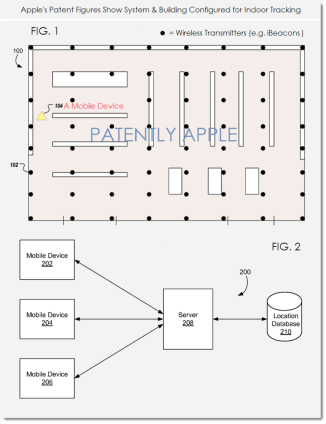“Finalists reflect diverse products and markets enabled by Bluetooth® technology”
Monthly Archives: April 2015
Indoor Location Services Intensify, historical solutions for sale and interesting new solutions arise
“Quuppa. An interesting highly accurate offering comes from Quuppa, a Finnish company with a bunch of high caliber researchers spun off from Nokia. Like some others, they are using Bluetooth Low Energy (BLE) beacons, but add angle of arrival (AOA) algorithms that pump up the precision, which they self-report to be 30 centimeters to 1 meter. With this performance, Quuppa has been used in sports to track hockey pucks and athletes’ movements during game play for coaching, player load monitoring and infotainment that can be broadcast during the game. The use of this type of high-precision location in health care settings is compelling. Patient flow management, security and critical asset tracking can be improved with precise positioning technology. Quuppa is a system that likely wouldn’t be used in apps that locate a coffee shop at a mall, but for uses that demand high performance and can spare some expense, it is compelling.”
A New Apple iBeacon Indoor Mapping Patent sheds more light on Future Location Services within Buildings
Facial Recognition, Beacon-Based Geofencing, Liquid Metal Technology Among New Apple Patents
“Patently Apple explains, Apple’s newly granted patent covers the use of facial recognition to lock and unlock a mobile device, adding a layer of security to their devices. Apple’s new beacon-based geofencing patent “covers their invention relating to methods, program products, and systems for multi-tier geofence detection.” This includes their indoor mapping technology, as Business Solutions Magazine reported. The technology uses wireless transmitters such as Wi-Fi transmitters, Bluetooth beacons, RFID, or other wireless transmission devices, that then transmit signals to mobile devices. It combines the mapping of static structures with the geolocation technology of tracking devices.”
Healthcare Data Loss = Tier 1 Concern
“Stolen credit card and bank account information has a short shelf life. Stolen health records can last a whole lot longer, and do a lot more damage. No wonder the FBI rates healthcare data theft as a Tier 1 concern, capable of inflicting “catastrophic or severe harm.””
http://m.healthcareitnews.com/news/rapidly-changing-technology-boon-hackers-headache-security
Healthcare and wearable technology: monitoring the connected body
““With the public fitness habit intensifying and the technology growing more intelligent, we are likely to see wearables playing a pivotal role in medical diagnostics, information sharing and general health in the not-too-distant future,” says NHS England’s medical director Professor Sir Bruce Keogh. “These devices will put patients in the driving seat of their own care and allow us in the NHS to predict things, act early and keep people safe and healthy in their homes for as long as possible.”
Van Hoof claims: “half of what determines our health is due to our behaviour. Eighty per cent of heart disease, stroke and type-2 diabetes could be prevented if the behaviour factors could be eliminated.”
“The change in healthcare needed is not just about wearables. In general, e-health, the use of telecommunications and IT to provide and improve clinical healthcare, aims to link patients and treatments over the Internet to save time, cost and resources and potentially save lives. The idea around e-health comes in varied forms: it could mean digital healthcare, such as electronic health records, assisted healthcare, telecare, telemedicine and the latest being wearable technologies.”
http://eandt.theiet.org/magazine/2015/04/wearable-healthcare.cfm
Future Medicine: Healthcare In The Digital Age
“Digital healthcare—a burgeoning field that can be segmented into three key areas: devices, digital doctors and data science—is part of a “digital revolution causing the creative destruction of medicine,” says Mr. Vaibhav Bhandari, director of product management at Optum, a subsidiary of the US-based United Health Group.”
“While digital health holds great promise, innovators should remain mindful of data security and patient safety, says Bhandari. Advances in digital healthcare technologies that empower patients may also increase the risks associated with less medical oversight, he cautions.”
Read more from Asian Scientist Magazine at: http://www.asianscientist.com/2015/04/features/future-medicine-healthcare-digital-age/
How healthcare technology is saving lives
” We live in an age where the use of technology dominates our lives and these technological developments have had an amazingly positive impact on the healthcare industry. Digital health technology has heavily influenced the improvement in our health and the increased life expectancy we are seeing today.
The following infographic created by Mission Safety Services outlines the progress we have made, the work that is being done, and possible future developments in healthcare technology that have potential to make real change.”
The Global Radiology PACS Market is Expected to Grow at a CAGR of 4.0% From 2014 to 2019
“The global radiology PACS market report defines and segments the concerned market with analysis and forecast of revenue. This market was valued at $1,861.0 million in 2013, and is expected to grow at a CAGR of 4.0% from 2014 to 2019.”
Global Healthcare Cloud Computing Market will Reach USD 12,653.4 million in 2020
 ” New York, Feb. 17, 2015 (GLOBE NEWSWIRE) — According to a new market report published by Persistence Market Research “Global Market Study on Healthcare Cloud Computing: Hybrid Clouds to Witness Highest Growth by 2020” the global healthcare cloud computing market was valued at USD 4,216.5 million in 2014 and is expected to grow at a CAGR of 20.1% from 2014 to 2020, to reach an estimated value of USD 12,653.4 million in 2020. “
” New York, Feb. 17, 2015 (GLOBE NEWSWIRE) — According to a new market report published by Persistence Market Research “Global Market Study on Healthcare Cloud Computing: Hybrid Clouds to Witness Highest Growth by 2020” the global healthcare cloud computing market was valued at USD 4,216.5 million in 2014 and is expected to grow at a CAGR of 20.1% from 2014 to 2020, to reach an estimated value of USD 12,653.4 million in 2020. “

